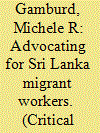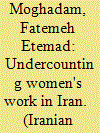|
|
|
Sort Order |
|
|
|
Items / Page
|
|
|
|
|
|
|
| Srl | Item |
| 1 |
ID:
087033


|
|
|
|
|
| Publication |
2009.
|
| Summary/Abstract |
Nearly a million Sri Lankan women labor overseas as migrant workers, the vast majority in the Gulf Cooperation Council (GCC) countries in West Asia. They are poorly paid and vulnerable to a wide variety of exploitative labor practices at home and abroad. Despite the importance of worker remittances to Sri Lanka's national economy, and in spite of the nation's history of organized labor and active political participation, migrants have received only anemic support from the state, labor unions, feminist organizations, and migrant-oriented nongovernmental organizations. The article contextualizes Sri Lankan migration within larger-scale economic dynamics (such as global capitalist policies and processes) and local-level ideological formations (such as local political histories and culturally shaped gender norms). The author argues that political freedoms in destination countries have a significant effect on organizing activities in both host and sending nations. Comparing the Sri Lankan and Philippine situations, the author contends that the vibrant activism in the Philippines correlates with the liberal organizing climates in the European Union and in East and Southeast Asia, while the paucity of organizing in Sri Lanka correlates with the strict repression of guest workers in the GCC. Compared to other destinations, the GCC countries give workers (particularly women) less chance for autonomous activities, are less open to labor organizing, and are less responsive to political protest.
|
|
|
|
|
|
|
|
|
|
|
|
|
|
|
|
| 2 |
ID:
087176


|
|
|
|
|
| Publication |
2009.
|
| Summary/Abstract |
This paper explores the possibility of a considerable undercounting of women's labor force participation in the official surveys in Iran. According to the official data, the proportion of females in the total active labor force was about 15.5 percent in 2006. Furthermore, according to the official data the share of female in total active labor in agriculture was about 10 percent in 1996. An examination of a large body of field research on the subject, however, suggests a much higher participation rate, about 40 percent of total agricultural labor. This paper will examine these studies and explore the reasons behind the underestimations. Pointing at the growing visibility of urban women in public space, the increasing share of skilled and educated women, rising cost of living, and the need for both male and female incomes to support an urban family, some observers have suggested that the official data underestimate urban female labor participation, as well. Informal urban labor, however, has not been adequately studied. Anecdotal information, however, suggests the existence of a significant female informal economy in both traditional and modern industries. In 2001, I undertook a micro study of 350 working age women in the affluent northern part of Tehran and found that a large number of educated upper and middle class women were active in the informal market. This finding was in sharp contrast to the studies in other developing countries in which informal participants are generally poor and unskilled and are unable to join the modern formal economy. This paper will also explore the reasons for undercounting of urban female labor.
|
|
|
|
|
|
|
|
|
|
|
|
|
|
|
|
|
|
|
|
|